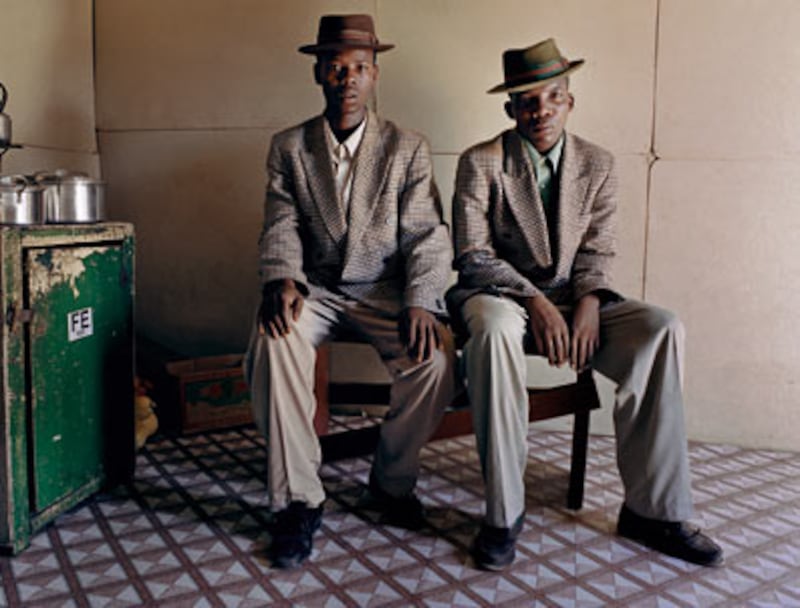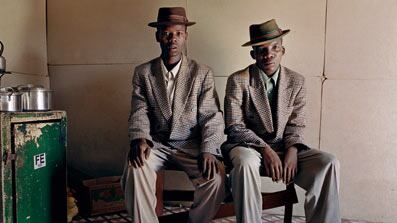Race should not be the elephant on the wall in Zwelethu Mthethwa’s photographic portraits of migrant workers in the settlements on the outskirts of Cape Town and Johannesburg. But, the history of portraiture in photography—and painting, for that matter—is written ostensibly on the representation of white people. This fact loomed larger and more significantly after the Sherrod debacle in which racial tensions of national proportion were cast in acute and reverberating relief. So, it is necessary to acknowledge that these are among the first series of large-scale color portraits of post-apartheid black Africans to be exhibited in New York, where they are currently on view at The Studio Museum of Harlem. That they are color portraits of black Africans made with the formal aesthetic considerations of a Western photographic tradition is also a relevant point.
Click Below to See Our Gallery of Zwelethu Mthethwa’s Photography

Black and white studio portraits of black Africans by Seydou Keïta and Malick Sidibé have been widely exhibited in the United States for years. Carole Squiers, a curator at the ICP, wrote a decade ago that “such images exist, taken mostly by African photographers for an African audience rather than by outsiders working for the international media. The way Africans picture themselves is quite different from what viewers in the West are used to seeing.”
Still, the international art market has long embraced the vernacular mid-20th century portraits of Keïta and Sidibé, not only for the novelty of regional subjects wearing native African fabrics with vibrant patterns, but because of what both photographers had accomplished—consistent, straightforward documentation in which the crisp visual clarity of description displays an implicit regard for the individual.
In Mthethwa’s photographs, the dignity of his subjects is immediately apparent. While their impoverished circumstances are likely to be alien to those who view these pictures in context of the gallery wall or in the beautifully produced book, Photographs by Zwelethu Mthethwa, just published by Aperture, these individuals present themselves with an unwavering physical elegance. Their makeshift homes might ruffle our first-world expectations of comfort, but the details are noteworthy and revealing—the smoothly painted corrugated cardboard walls; surfaces meticulously papered with magazine spreads; the wit of a large clock on the wall designed as a wristwatch; perfectly made beds; consistently immaculate spaces. Not to gloss over such abject conditions, but, certainly, the care brought to each living environment underscores the self-respect of these people.
As an art student in the early 1980s, Zwelethu Mthethwa (pronounced Zwai-le-too Ma-tet’-wah), was forced to overcome a legislative obstacle of apartheid: As a native black South African, he had to justify attending the University of Cape Town’s Michaelis School of Fine Arts, a "white" institution, by taking courses that were not offered at a black university. So he chose photography. He would go on to earn a Masters degree at the Rochester Institute of Technology, in New York, on a Fulbright Scholarship.
In apartheid Africa, blacks were required to carry identification cards with their pictures in black and white. Mthethwa’s deliberate use of color is one way for him to distinguish the representation of black Africans, but, at the same time, his use of color incorporates a host of aesthetic concerns.
Originally trained as a painter, Mthethwa brings a determined visual formalism to the portraits of his subjects in their homes. His well-organized compositions are stylish in a manner that does not contradict his subjects. One woman, lying across her bed in a striped sweater and long pants, conjures Manet’s Olympia. The wall behind her is made of cardboard and painted a peacock blue, and it functions in spatial terms as a studio backdrop.
Mthethwa’s portraits subvert the earlier tradition of African portraiture, according to Jack Shainman, whose Chelsea gallery represents him, as well as Sidibé. “Hand-held camera; no lights; his use of color. He doesn’t want to put a barrier between him and his subjects,” said Shainman.
“I wanted to give some dignity back to the sitters,” Mthethwa says about his choice to photograph his subjects in color. “I wanted them to have a sense of pride, and, for me, color is a dignifying vehicle.”
Mthethwa believes that black and white photographic reportage was complicit in denying indigent black Africans any claim to individuality. “It placed them within the status of news items: victims rather than persons, specimens rather than individuals,” Okwui Enwezor, the renowned critic and curator, and editor of Nka: Journal of Contemporary African Art, writes in the Aperture book about Mthethwa.
The social conditions to which these people are subjected are an underlying narrative that Mthethwa chooses not to introduce in captions. All the images are “Untitled,” an intentional decision to avoid the documentary meaning that might be ascribed to his work. The images speak for themselves. One picture, for example, shows two seated teenage boys stylishly dressed in matching attire. It is up to the viewer to respond to who they are and, perhaps, to imagine why they are dressed to the nines. Still, the back story, told to me by Shainman, adds multiple layers to the meaning of the picture: The two boys were photographed after returning from a Christian Zionist ritual of manhood where they were circumcised without anesthesia or antibiotics; they are required to wear their outfits for three months as public confirmation that they underwent the ritual.
Mthethwa’s body of work includes portraits of black workers—sugar-cane cutters, brick workers and coal miners—photographed in the landscape of their labor. In 2005, he made a series called Common Ground, in which he combined images of outlying settlements in South Africa with neglected African-American neighborhoods in post-Katrina New Orleans, underscoring the interchangeability of these overlooked black communities in our country and in his.
“My ongoing commentary about African life is that I look at the periphery where you have people who are almost down and out and where there is a lot of honesty and a lot of truth about the living conditions of the masses in Africa,” Mthethwa said in a recent interview with Tim Noakes on Dazed Digital.com. “The periphery is very important because that is what is driving the mainstream.”
Plus: Check out Art Beast, for galleries, interviews with artists, and photos from the hottest parties.
Philip Gefter writes about photography for The Daily Beast. He previously wrote about the subject for The New York Times. His book of essays, Photography After Frank, was recently published by Aperture. He is currently producing a feature-length documentary on Bill Cunningham of the Times, and working on a biography of Sam Wagstaff.





